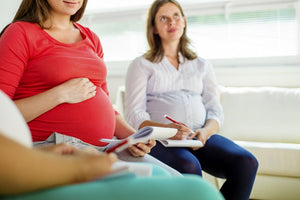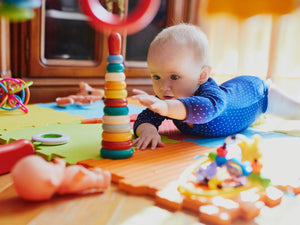Key Takeaways
- Breastfeeding is a learned skill that requires patience, practice, and proper technique to ensure comfort and success for both mother and baby.
- Recognising early feeding cues, such as sucking motions or putting hands in their mouth, can help keep your baby calm and make latching easier.
- Good breastfeeding technique, including proper positioning and attachment, prevents nipple pain and ensures effective milk transfer and feeding.
- Using nipple balm with organic ingredients, keeping nipples hydrated, and addressing any issues early with professional support can maintain nipple health.
Maintaining Nipple Health During Breastfeeding
Breastfeeding, although natural, is a learned skill for you and your baby.
It is good to remember that this may take a little while to get the hang of it – but once you do, you may find it really enjoyable and rewarding.
When you begin breastfeeding, your nipples may be sensitive and you can expect some early nipple tenderness. Patience and practise in the early stages, especially ensuring good attachment and taking care in getting baby on and off the breast should minimise sore, cracked nipples and this should cease to be a problem after the early weeks.
Here's how to care for your nipples while breastfeeding;
Look Out For Early Feeding Cues
Try to offer a feed before your baby starts crying. Crying is often a late feeding cue and may be an indication of stress, making it harder for them to attach.
Taking early feeding cues may help keep your baby calm. They can include:
- Making sucking motions with their lips
- Opening and closing their mouth
- Sticking out their tongue
- Puckering their lips
- Moving their head from side to side, as if looking for something
- Putting their hands in their mouth and sucking on them

Establishing Good Technique
The well-attached baby can help prevent many breastfeeding problems, causes no nipple pain and drains the breast well. To maximise your success:
- Position yourself comfortably with back support, pillows supporting your arms and in your lap and your feet supported by a footrest if possible
- Position baby close so that your baby does not have to turn their head to reach your breast with their mouth and nose facing your nipple
To check that baby is attached well, look for these signs:
- Chin is pressed into the breast and nose is clear or only just touching the breast
- Mouth is open quite wide and lips are not sucked in
- Tongue is forward over the lower gum (may be difficult to see – but don’t pull bubs away to check or you might detach)
- Your baby has much of the areola in their mouth, more so on the ‘chin side’
- There is no pain (new mums may feel a stretching sensation as the nipple adjusts to being drawn out)
- You may notice your baby’s whole jaw moving they suckle and even their ears wiggling!
- They should not be sucking in air or slipping off the breast and cheeks should not hollow as they suck
After feeding, check your nipples for signs of stress, such as red stripes or a squashed look. If you have these signs, double check that your baby has latched on correctly during your next feed.
Properly detaching baby from your breast by correctly breaking the suction with clean finger inserted in the corner of baby’s mouth before removing them from the breast and allowing your baby to self-attach as often as possible while you both learn will also give you the best chance of avoiding damaged nipples.
Choose A Good Nipple Balm
You may wish to use a nipple balm to keep the skin on the nipple itself and around the areola hydrated. This is to help prevent dryness and keep your nipples in good condition, making it easier for your baby to latch onto.
Look out for a balm made with edible, organic oils so you don’t need to wash it off before a feed and apply after each feed to keep your nipples soothed, hydrated and protected.

Other Tips You May Find Helpful:
- Before feeding, express a few drops of milk and smear on the nipple
- If your breasts feel full and tender, massage your breasts gently and apply warmth, like a heat pack (ensuring it is not too hot) to help get your milk flowing
- Leave your bra open for a few minutes until nipples are dry
- Change nursing pads frequently. Consider washable nursing pads if disposable ones are chafing
- Avoid using anything on your nipples that is drying or may damage your nipple skin (eg soap, shampoo, rough towels).
Seeking assistance early if you are having difficulty is really important and can prevent further problems from occurring.
You can contact your medical adviser, a lactation consultant, child health nurse or an Australian Breastfeeding Association (ABA) breastfeeding counsellor.
About the Author:
Written for Nourish Baby by Michelle Vogrinec
Michelle Vogrinec is a mother of three and creator of GAIA Natural Baby. An avid researcher with an interest in preventative health and sustainable living, she is passionate about the environment, complementary medicine and growing fresh, organic fruit and veggies to support her family in maintaining a healthy lifestyle.
Michelle aspires to empower others to follow their dreams, achieve their goals and live the life they desire.
Our Products
-

01. Guide to a Healthy Pregnancy
$55 -

02. Positive Birthing Course
$55 -

03. Infant Feeding Guide
$55 -

04. Baby Sleep Guide - First 12 Months
$55 -

05. Toddler Parenting Course 1 - 3 Years
$55
-
 When to Start Antenatal Classes?
When to Start Antenatal Classes?
Becoming a parent is an incredible milestone, but it comes with a host of changes that can be daunting, especially for first time parents. Antenatal classes are all about offering expectant parents the education they need to make informed decisions, look after their bodies and care for their newborn babies. While you probably already have a long list of things you need to accomplish during your pregnancy, it’s a good idea to make time to attend antenatal classes.
-
 Development Milestones 4-8 Months
Development Milestones 4-8 Months
As they reach the middle of their first year, you'll start to see bigger leaps in their growth and ability!
In this article, we’re going to discuss your baby’s developmental milestones between 4-8 months, and what you can expect along the way.





 When to Start Antenatal Classes?
When to Start Antenatal Classes?
 Development Milestones 4-8 Months
Development Milestones 4-8 Months








